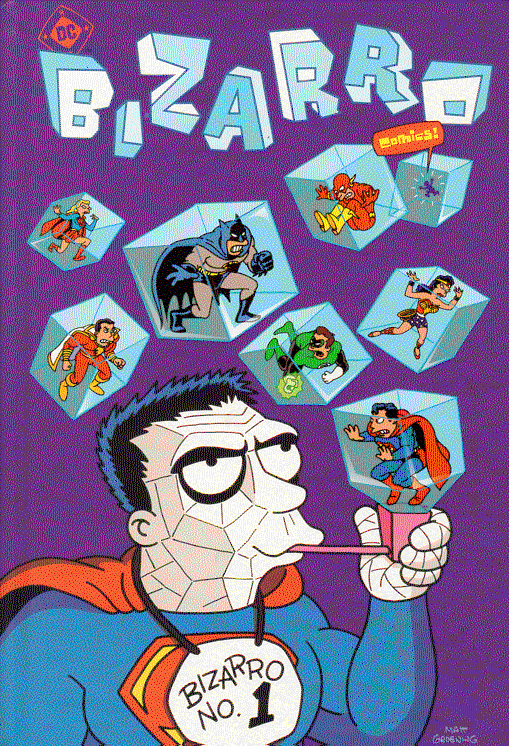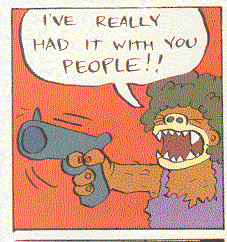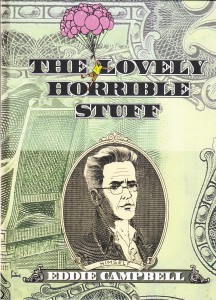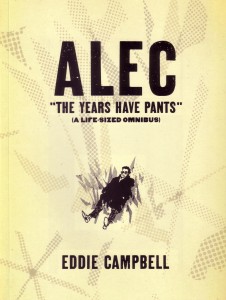It’s constantly annoying to me that Eddie Campbell isn’t fabulously wealthy. He seems to get by OK, judging from his comics (it’s not like I’d have any other way to assess his finances), but somebody who has been putting out some of the best comics in the world for 30+ years now should be sleeping on a pile of money. This particular graphic novel, as you may have guessed from that cover, is all about cash, and that title should give you some idea of Eddie’s opinion on the subject. He gives us a tiny peek into how his finances work, why it’s a terrible idea to ever loan money to a father-in-law and why timing in pitching any sort of tv show based on him or his work is everything (anybody else remember that global financial catastrophe that started in 2008? I know that American voters seem uncomfortably hazy on the subject, but I’m hoping the rest of the world has better memory). Eddie wanders around a bit, but the conclusion is the same as always: the man just wants to make art and live a comfortable life. It’s a little disconcerting to see his kids as young adults, as I remember them as the tiny creatures from his earlier books, and it’s even more annoying that he has to worry about their college fund. Anyway, my bitching about the total lack of justice in the world isn’t going to change anything. The second half of the book is a bit more dry, as it’s all about an obscure form of currency from the island of Yap, what’s happened to it over the years and how it’s value was measured obliquely preceded some of the other tricks that are a huge part of the current global finance system. And they’re very large circular rocks with holes drilled in the middle of them, so their construction and how they got from place to place was also covered. This book was a bit of a departure from some of his other graphic novels, as he liberally sprinkled in pictures of people and places to mix with his drawings, which served as a vivid reminder of the almost invisible line between his character of Alec and his real world. It’s another great graphic novel from one of the best comic artists/writers working today, and there’s no reason in the world why you shouldn’t have a copy of it. Unless you hate really great books, in which case you seem to have wandered into the wrong website. $14.95
Moore, Alan & Campbell, Eddie – From Hell
July 24, 2011From Hell. Christ, talk about a nostalgia overload. I first saw From Hell in any form when I picked up a copy of Taboo #4, which I believe had the third chapter of the story. This was probably in 1993, so this along with the suggestions of Dave Sim led me to hunt down everything I could find from Eddie Campbell (I already knew all about Alan Moore, as Watchmen was one of the books that got me started down this independent comics path). Eventually I picked up a few more issues of Taboo before that publishing company went under, then over the years I successfully managed to get all of the individual issues when they came out for Tundra and Kitchen Sink Press, two more companies that are no longer active. The point of this extended introductory ramble, outside of letting you all in on what this book means to me, is to point that this is the first time I’ve read the book in its collected form. Sure, I read through the comics all in a row once, but that includes all of the letters pages and asides that come with individual issues. Reading this all in a chunk is a revelation. I remembered loving the book, obviously, but it’s only when you have it in a chunk that you can really see all of the tricks that Moore was trying to pull. For those of you who have never heard of small press comics but have somehow hit this review, From Hell is Moore & Campbell’s version of what happened with the Jack the Ripper murders. I say “Moore & Cambpell” because even though Moore is obviously the writer, this book would have been something else entirely under the hands of a different artist. Eddie’s depictions of the steady rains, foreboding shadows and the brutally graphic murder scenes is what I think of even today when somebody mentions Jack the Ripper. If you’re a history buff and think you have a good theory on who committed the murders, might I suggest reading the lengthy appendix with Moore’s notes? These things are meticulous and list his thoughts practically page to page, and they answered every question I had about why he went in certain directions. Most people are content to call it a day after 400+ pages, but Moore instead offers a peek into his writing process that feels like a necessary epilogue instead of a tacked-on filler piece. As for the execution of the story, again the word I would use is “flawless.” The idea that nobody in authority was able to figure out these murders was always a little hard to swallow, so Moore has come up with a more plausible explanation. He’s the first to admit every step of the way that this is all fiction, but he also clearly took the time to learn all of the fine points of the murders and the investigation. If you’re reading along and have noticed that I’m not going into any kind of chapter by chapter analysis, that’s for a reason: this is in my personal top 10 (probably top 5) and I’m thrilled that Top Shelf was nice enough to send along a review copy. Picking it apart piece by piece would take weeks and kill some of my enjoyment of the book, so why bother? It’s an entirely different experience from reading it issue to issue, and it’s also clear that they fixed up a few panels here and there. Oh, and just in case this giant book with a lengthy appendix isn’t enough content, they also included the rare “Dance of the Gull Catchers” story. If you’re a fan of this medium and don’t already have this book on your shelf, the only excuses I can think of are excessive poverty or ignorance. One is more easily rectified than the other, granted, but there are always local libraries that tend to have this on the shelf if all else fails. $35
Campbell, Eddie – Alec: The Years Have Pants
January 11, 2011Alec: The Years Have Pants
So! Eddie Campbell. He’s one of the first people I discovered after making the transition from the super hero stuff (kudos to you if you were smart enough to jump right into the good stuff, I was not), and his Bacchus series definitely was a major cause in keeping me interested while I was at a stage of life where I would have just as soon given up on the funny books. Still, I had to see what happened in the various Bacchus stories each month (and Cerebus too at the time), so I couldn’t just stop going to the comic store altogether, then my social life lessened a bit, somebody said “Instead of complaining about the lack of decent small press sites out there, why not just make your own?” and here I am, still rambling, almost ten years later. No, I’m not saying I’m in Eddie’s league, don’t think that for a second. I’m just saying to all the people who get some value out of this site: I wouldn’t be doing this if it wasn’t for him. So if you haven’t read any of his books, it’s clearly meant a lot to me. This is also the cue for anybody who wanted an unbiased review to hit the exits, as it simply isn’t possible for me to read chunks of this book without a nostalgic reaction. Sorry, I tried to remain objective, and it just wasn’t possible. My only real concern with this book was that several parts of it were literary landmarks in my life. The King Canute Crowd (known to me as “The Complete Alec” back in the day), Graffiti Kitchen, The Dance of Lifey Death, these all hit me square in the face when I first read them. I was afraid that having them all clumped together would lessen their individual impact, that it would all run together. In a way I was right, but in a much bigger way having them finally all in one collection makes them part of a much greater whole, and every story is actually improved because of it. I didn’t think it was possible, but there you go. I’ll get into the bits in a minute, but as a whole this was brilliant, or fill in the blank for your personal description for the best thing ever. I couldn’t even bring myself to scan an internal image because I didn’t want to risk damaging the spine for the scanner, even though in five years this thing will probably be a dog-eared mess from loaning it to friends and referencing various parts. I don’t know how the sales were for this thing, as the price and size might have scared people away, but there aren’t many graphic novels (or whatever you want to call this genre) that are better. Frankly, if I saw the bookshelf of a small press person and this wasn’t on it, I would think less of them. Hey, maybe I should talk about the inside a bit? I was going to do full reviews for each bit, but am dialing that back a bit after the lengthy opening ramble.
The King Canute Crowd:Â My first experience to Eddie. I’d seen autobiographical stuff before, but never a less self-conscious pile of stories, and never anything that spoke to me as clearly as this did. Moments that still make me smile include Danny Grey pissing in a handbag, that malevolent teddy bear, Eddie’s easy but ridiculous job, and how he never knew where he was going to wake up from day to day. For years this WAS the Alec story, and it holds up even better than I thought. One of those rare books that I could almost certainly identify from being shown any random panel.
Graffiti Kitchen: Garooga! This one hit me like a ton of bricks when I first read it. Absolutely brimming with life, in a way that I’ve rarely seen since, and as such it’s not something that’s easily defined. There’s a reason why this is considered by many to be the best of the Alec books, and I’ll be damned if I’m going to try and figure out why here.
How to Be an Artist: I vaguely remember not giving this the greatest review when it first came out, but after reading it again here I haven’t the foggiest idea why that would be the case. I think I wasn’t that thrilled about the idea of watching comic art evolve throughout all recorded history, but that only lasted a few pages and it’s fascinating to me now. Even outside of all that, it’s an engrossing life story to anybody who has been around this small press end of things for as long as he has. Reading about the various troubles along the long path, his breaks with artistic faith and how it all led somewhere great in the end was damned near heart-warming without being the slightest bit sappy. That’s a tough thing to pull off, and it seems effortless here.
Little Italy/The Dead Muse: Collections of shorter bits, so they’re lacking the punch of the bigger stories, but there’s plenty of genuinely funny stuff, and his insights come just as easily in shorter pieces. The Dead Muse originally had all kinds of older work from other artists, including an old piece from Dylan Horrocks, but they were taken out for this edition. I have the old copy with all the artists included because I am just that cool (and went on an Eddie Campbell scavenger hunt when I first discovered his work), and it’s fine without it, but interesting to wonder what the hell happened to most of those people. In the context of this giant book, these short pieces also break things up nicely, adding to the whole again.
The Dance of Lifey Death: This one has shorter pieces and longer pieces, but deep down it seems to mostly be about mortality. Again, this one hit me too squarely back in the day to have an objective opinion about it now, and it remains one of those important pieces of literature that people should just fucking read already. We’re all heading for the grave eventually, might as well enjoy the dance along the way.
After the Snooter: This is all the new “Alec” stuff he was doing in the back pages of Bacchus, right around when he was running out of old material to reprint. Ah, Bacchus, I hope the rumors are true and Top Shelf is giving that series this same treatment. It’s a bit scattered, as a big story doesn’t seem to have been the idea, but The Snooter is a fascinating concept for a character and several bits had me laughing out loud. Just to be clear, that’s a rarity when I’m reading most comics (sadly), and portions of this entire book had me laughing quite a bit.
The Years Have Pants: Finally got around to the new stuff! OK, let’s say you’ve already read all of his stuff, have nice copies of it all and don’t see the point in spending $35 (for a softcover) for this book. Is it worth it for 40ish pages of new material? Well, you’re already leaving out the new pages that dropped in here and there, and the shorter sections I skipped over with stuff that you’ve almost certainly never seen from various comics, but let’s stick with that complaint. Is it worth it for this bit of new stuff? Drum roll please… of course it is! What did you think I was going to say? If it was terrible I’d say you should buy it just to give this man (and the fine folks at Top Shelf) some cash. It’s not terrible. Far, far from it. For one thing, all those children from past stories are all grown up, so this is the perfect ending for the volume. There are still plenty of genuine insights (I enjoyed the bit where he says he can’t even imagine being like his King Canute days and waking up on random floors at his age), funny bits and emotional moments. It’s the perfect cap to the perfect book. Look, at this exact moment it’s snowing and miserable out here. This is the perfect book for days like this. Granted, maybe not so much for taking to the beach because it5’s a brick of a book at 64oish pages and maybe you don’t want to carry it to the beach, but it ‘s perfect for many other settings. Buy it and you absolutely won’t be disappointed. $35
Various DC Anthologies – Bizarro Comics Volume 1
April 27, 2010
Well, the book I’ve been holding my breath for since I heard about it in the planning stages is finally here. All the best small press people, all in one book! All Bizarro stories, all the time! Little seen talents finally getting a chance to shine on the big stage! And the end result is… mixed.
Oh, don’t get me wrong, there are moments in here that make it worthwhile, enough so that I can recommend getting it. You could probably wait for the softcover to come out and save $10 or so, because there’s nothing in here that couldn’t wait a few months. If you don’t know the concept, DC apparently decided to give all these “no name” people a chance. If anybody knows the complete story behind this book, let me know. I’m curious as hell to see how this got organized. And whose decision was it to put pairings on all of the stories instead of just letting one person shine? Granted, some of the pairings boggle the mind: Dylan Horrocks and Jessica Abel, James Kochalka (writing and not drawing!) and Dylan Horrocks, Jef Czekaj and Brian Ralph, Eddie Campbell and Hunt Emerson, Ivan Brunetti and Evan Dorkin, Evan Dorkin and Steven Weissman… it’s a hell of a list, don’t get me wrong. But most of these guys spend their time doing their own thing and I think it would have flowed a lot better if they had been allowed to do that here. Granted, you would have to bring in a color guy for most of these people that have never used it, but they do everything else themselves.

The story (such as it is) is this: a creature called A comes to Mxyzptlk’s world to try and take over. He challenges M to a best-of-seven of games, but M is disqualified and has to choose a champion. Remembering his past problems, he chooses Superman but can’t find an appropriate alternate universe substitute after the original one doesn’t believe him, and accidentally chooses Bizarro. Make sense? It doesn’t matter. Bizarro decides to win the contest by drawing a bunch of stories, and these stories are all the ones by the small press folks. When it goes back to the “story”, these comics are promptly forgotten about and the challenges begin, but not before they get an insult or two off about the quality of the comics. Which, I’m sure, is just an insult in the story directed at Bizarro and not the creators, but it’s pretty easy to take it the wrong way. The main story takes up about 60 pages of a 236 page book, which wouldn’t be that bad if it didn’t mostly suck. It has a few moments, but the thought that this story was expanded upon at the expense of some of these extremely talented guys doesn’t make sense at all to me.
Flipping through this again to write this, I see that I enjoyed almost all of the shorts in this. I didn’t really like Wonder Girl vs. Wonder Tot, Help! Superman!!, Batman, and The Most Bizarre Bizarro of All! Compare that to the 23 other stories that I liked a lot, and it looks like they have a winner here. The Bat-man (by Chip Kidd and Tony Millionaire and strangely, the only black and white story in the book) is brilliant. Old school classic Batman here, and he’s ugly as hell. Hawkman (James K. and Dylan Horrocks), while not drawn by James, has the same feel that I’ve come to know and love from all his work. Kamandi (Nick Bertozzi and Tom Hart) takes the cake for me as the best story in the book, but I’m hopelessly biased because Tom Hart drew it. That’s Really Super, Superman (Ivan Brunetti and Evan Dorkin) is a close second, and First Contact (Mark Crilley and Andi Watson), about the Atom, is up there too.
I was expecting a hell of a lot from this book, and I’m not sure that I got it. What I did get, however, is a thoroughly entertaining look at a lot of DC universe told through the eyes of some of the most talented people working in comics today. If I cared at all about the characters this probably would have been a great book, or maybe if they had allowed them to work by themselves, or maybe if DC had given them a little more room (and a lot more people. The names excluded here are too numerous to mention, although I am surprised and gratified by some of the selections) to the creators. All in all, if you like even half the people in this book, get it. If you like Evan Dorkin, Sam Henderson or Dylan Horrocks, they’re all in here a few times writing and drawing but not, as I’ve made pretty clear by now, doing both things at once. The Matt Groening cover makes the book, too. And yes, I did see the Dan Clowes cover in The Comics Journal and I thought it was great, but I think this is a better cover for the tone of the book.





 Posted by Kevin
Posted by Kevin 






